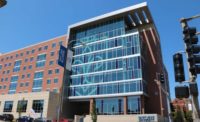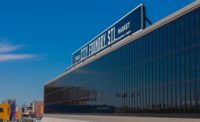Commercial buildings and industrial facilities across the U.S. produce approximately $400 billion annually in combined energy costs. Unfortunately, nearly 30 percent of that energy is wasted each year. The good news is, there is definite room for improvement. Architects, building owners and facility managers have the opportunity to design and maintain buildings that help reduce the total consumption of energy throughout the U.S. Energy costs can be brought down significantly with even the smallest green initiatives, and commercial roofs especially have incredible energy saving potential.
However, implementing the right strategies and products is vital for making a powerful impact on the environment as well as decreasing overall building costs annually. The following strategies can be utilized to improve your building envelope’s energy efficiency, which can lead to decreased operating costs:
Specify Efficient Lighting in Conjunction with Daylighting Systems
Efficient lighting systems when used in conjunction with daylighting can significantly reduce electricity costs and increase energy savings. Daylighting is a strategy that can contribute to savings by turning off or even removing electric lighting units inside buildings to reduce nearly one-third of total energy costs. Lighting typically tops the list as a main consumer of energy when looking at the breakdown of energy consumption by building category, accounting for nearly 35 to 50 percent of total electricity consumption.
In order to truly maximize the energy efficiency of a daylighting system, building owners and facility managers need to ensure that lights are equipped with controls that allow lighting to be dimmed or turned off completely when sufficient illuminance is achieved through daylighting. Lighting creates waste heat, which can increase cooling costs and requires more energy from your commercial building to cool down. Controlling the use of these lighting units will only supplement a daylighting strategy. In order to ensure a daylighting system performs to its full potential, it’s important to utilize an integrated approach and work strategically with the entire building team.
It’s essential to evaluate your daylighting plan from a design perspective as well. Strategically placing daylights throughout a commercial building may help ensure maximum energy efficiency. Other factors that are crucial to consider include the design of the building’s interior, climate, architectural features, exterior and interior obstructions and more.
Re-Roof with Sustainable Insulation
Insulation is used to control energy flow throughout a building envelope, but not all insulation is created equal when it comes to energy efficiency. Mineral wool and polyiso are two commonly used insulation materials for commercial buildings. Mineral wool, also known as slag wool, is comprised of heated slag, stone or molten glass, which are then spun into small fibers. Polyiso, on the other hand, is a light, closed-cell rigid board that is used in about 70 percent of commercial roof construction. When it comes to energy efficiency, polyiso is the more sustainable option from production to installation.
Mineral wool also requires 85 percent more energy to manufacture and has a Global Warming Potential (GWP) that’s 3.5 times higher than polyiso.
Once it’s installed, polyiso delivers exceptional thermal performance throughout the life of the building, with its R-value being between 5.6-5.8 per inch, which is approximately 48 percent higher than that of mineral wool. The higher the R-value of insulation, the more effective it will be in reducing energy consumption. Polyiso can also be recycled and re-used on roofing applications, while mineral wool cannot. However, whether or not it can be reused will depend on whether a complete tear off or a roof recover is taking place. Typically, a tear-off may require additional inches of insulation to be installed.
Utilize Reflective Membranes
Reflective roofing membranes, otherwise known as cool roofs, are a common energy saving strategy for commercial buildings. Most roofs are exposed to the sun for nearly 12 hours per day, and during this time, that heat doesn’t just stay up on the roof – it’s transferred throughout the entire building, causing cooling costs to increase. Reflective membranes like EPDM and TPO can assist with decreasing that temperature, which can lead to significant energy savings. In fact, according to the U.S. Department of Energy, cool roofs could decrease roof surface temperature by more than 50 degrees Fahrenheit.
The warmer the climate, the greater the energy cost savings potential. However, cooler climates can reap the benefits as well – though the margin of savings may merely be smaller. For example, warmer cities like L.A. and Phoenix could see a potential energy savings of $35-37 million over the course of one year. Even after aging, reflective membranes have been shown to demonstrate energy savings in warm climates. Maintaining reflective membranes, however, is crucial in order to reap their full energy potential. If the roof is not cleared of elements like debris and moisture, the membrane may not be as effective in decreasing the ambient temperature.
Cool roof coatings are an additional viable option for not only improving building aesthetics, but reducing energy costs, as well. They may even help prolong the life of the current roof. Just like reflective membranes, coatings work to ward off UV rays to protect the underlying system and minimize cooling costs. In order for a reflective coating to provide any benefits, however, the original roofing system must be in good condition and thoroughly cleaned prior to the coating being applied. The overall energy savings will depend on factors ranging from geographic location and insulation.
Install Vegetated Roofing
Green roofs are a popular sustainable roofing option not just for their aesthetic properties, but for their energy saving benefits as well. Vegetated roof systems are recognized as providing some thermal performance (heat flux reduction) and provide shading and aid in cooling the air around the building through evapotranspiration. This reduces the pressure put on a facility’s mechanical heating and cooling systems for the floor directly below the vegetated roof. However, the actual thermal performance varies widely and is dependent on building design, time of the year, depth of media, vegetation type and coverage, as well as the amount of water held within the system. Vegetated roofs help mitigate the Urban Heat Island Effect by covering heat absorbing materials with vegetative systems. Vegetated roofs also protect the underlying roof system from extreme temperatures and ultraviolet (UV) rays, extending its service life and delaying roof replacement or restoration.
Know When to Re-Roof
Damaged or worn out commercial roofing systems have the potential for significant energy loss. If a roofing system is too far damaged, a roof coating wouldn’t be sufficient enough to solve the problem. For instance, extensive moisture damage or significant devastation to the underlying structural deck may warrant a complete roof tear-off. It’s important to familiarize yourself with building codes, which can also dictate whether or not a commercial roof would have to be replaced. However, if the roof insulation remains in good condition and there is minimal damage to the membrane, a re-cover could be sufficient. Roofing contractors and design professionals can help you determine which strategy is best for repairing your roof, whether that means implementing a completely new system, utilizing a roof overlayment or applying a coating.
No matter geographic location or budget, there are always energy saving strategies that can be implemented into your commercial facility. A renovation as significant as a complete roof tear off isn’t always necessary for increasing energy efficiency. In fact, improving efficiency can be as simple as adding daylighting to your building to supplement lighting units, ensuring lights are dimmed or turned off entirely when sufficient illuminance is achieved, or ensuring that your reflective roofing membrane is properly maintained. Each sustainable strategy offers its own benefits, and working together with the entire building team can help your commercial building realize its true energy saving potential.






